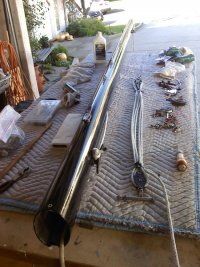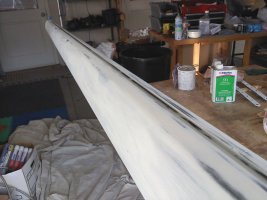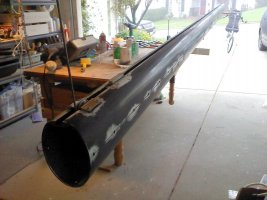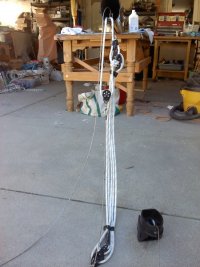Retired from newspapers and television, currently sailing Thelonious II, a 1984 Ericson 381.
My black Kenyon boom was in pretty good shape, just a few dings and a bit of bubbling around the SS fittings. But the outhaul car was frozen in the track and the outhaul and topping lift gear were jammed deep inside. In my garage the end caps came off easily, and after probing inside with a 2x4 I was able to free up the mess of blocks and draw them out. My 3:1 outhaul had tangled with the single-block topping lift over the years, and the cheeks of one block had become a jagged snare.
I decided to increase the outhaul to 4:1 with one new Harken block. Would that be enough? Other threads here have proposed much greater outhaul power by rigging cascades inside—and I have a new loose-footed mainsail, my first ever on a cruising boat. I concluded I should keep it simple because of the former jamming issue and because I won’t be racing this boat. Some care to keep tension on the internal rig should prevent fouling in the future.I really wanted to save the big, robust SS outhaul car, and worked on it with PB Blaster and constant coaxing for days. No dice—corrosion had welded it to the boom track. I had to saw the car off with a Sawzall.
 ....
....
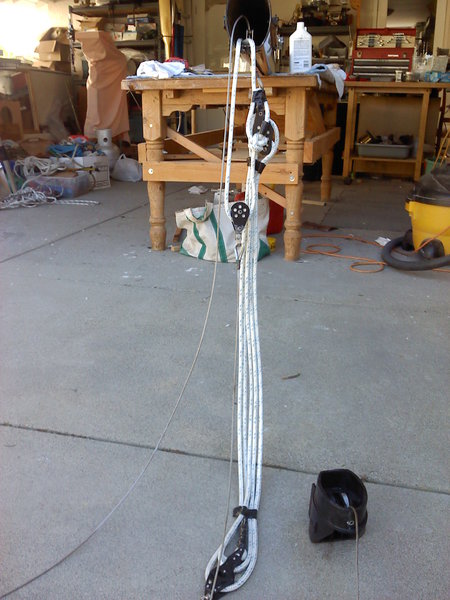
I should learn to leave well enough alone, but that wouldn’t be any fun so I decided to paint the boom. There’s much discussion here on spar painting, but I was impressed by a simple plan advocated by “Jay”, a moderator on the Interlux forum. I followed his recommended sequence to the letter.
Since the current paint is in good and sound condition, there will be no need to completely remove the coating itself. However I would recommend that you follow this system to ensure sound adhesion between the coatings:
1. Wipe the surface clean with Special Thinner 216
2. Sand the surface with 120 grit paper (ensure that the bare aluminum spots are bright, white metal)
3. emove all sanding residue with Special Thinner 216
4.Immediately (within 1 hour) apply 1 coat of Pre-Kote Primer which has been thinned 15% to the entire surface
5.Sand the Pre-Kote with 220 grit paper
6. Remove all sanding residue with Special Thinner 216
7. Apply a 2nd coat of Pre-Kote
8.Sand the Pre-Kote with 320 grit paper
9. Remove all sanding residue with Special Thinner 216
10. Apply 1 coat of Brightside
11.Sand the Brightside with 320 grit paper
12. Remove all sanding residue with Special Thinner 216
13. Apply the 2nd and final coat of Brightside


Interlux Pre-Kote is easy to use. Lay it on and sand most of it off. It fills imperfections nicely. And according to “Jay” it makes a good primer even for bare aluminum. I hope he’s right.
I like Brightside paint—or at least I’ve used it before, rolling and tipping. It seems to require thinning, and a degree in micro-meteorology to know how much on any given day or time of day. Unthinned, it can sag. Thinned, it needs a lot of coats—each one possible to screw up. Sometimes the roller leaves a million tiny bubbles. Sometimes another pass with the same roller removes them. Sometimes immediate tipping with a foam brush does. For me at least, the real threat is sags, so I roll very thin and fast and don’t tip much. The boom took four coats.
The result was an A-minus. Oh, it looks fine—but I could never get a perfectly uniform gloss. I think the issue was high-gloss black. It’s pretty unforgiving. After letting the paint cure for a week, I improved the result with some compounding polish and a coat of wax.
All stainless fittings were well coated in Tef-Gel.The final black finish seems hard and durable and resistant to scratching.We’ll see how it holds up. Truth is, I think even Rustoleum spray paint would have worked. A boom is easy to work on if you can take it home. Now if they only made Interlux Brightside in a spray can….[Update: They don't but we can. Thin Brightside 30-40 percent and use disposable Preval aerosol sprayers.]
I decided to increase the outhaul to 4:1 with one new Harken block. Would that be enough? Other threads here have proposed much greater outhaul power by rigging cascades inside—and I have a new loose-footed mainsail, my first ever on a cruising boat. I concluded I should keep it simple because of the former jamming issue and because I won’t be racing this boat. Some care to keep tension on the internal rig should prevent fouling in the future.I really wanted to save the big, robust SS outhaul car, and worked on it with PB Blaster and constant coaxing for days. No dice—corrosion had welded it to the boom track. I had to saw the car off with a Sawzall.


I should learn to leave well enough alone, but that wouldn’t be any fun so I decided to paint the boom. There’s much discussion here on spar painting, but I was impressed by a simple plan advocated by “Jay”, a moderator on the Interlux forum. I followed his recommended sequence to the letter.
Since the current paint is in good and sound condition, there will be no need to completely remove the coating itself. However I would recommend that you follow this system to ensure sound adhesion between the coatings:
1. Wipe the surface clean with Special Thinner 216
2. Sand the surface with 120 grit paper (ensure that the bare aluminum spots are bright, white metal)
3. emove all sanding residue with Special Thinner 216
4.Immediately (within 1 hour) apply 1 coat of Pre-Kote Primer which has been thinned 15% to the entire surface
5.Sand the Pre-Kote with 220 grit paper
6. Remove all sanding residue with Special Thinner 216
7. Apply a 2nd coat of Pre-Kote
8.Sand the Pre-Kote with 320 grit paper
9. Remove all sanding residue with Special Thinner 216
10. Apply 1 coat of Brightside
11.Sand the Brightside with 320 grit paper
12. Remove all sanding residue with Special Thinner 216
13. Apply the 2nd and final coat of Brightside


Interlux Pre-Kote is easy to use. Lay it on and sand most of it off. It fills imperfections nicely. And according to “Jay” it makes a good primer even for bare aluminum. I hope he’s right.
I like Brightside paint—or at least I’ve used it before, rolling and tipping. It seems to require thinning, and a degree in micro-meteorology to know how much on any given day or time of day. Unthinned, it can sag. Thinned, it needs a lot of coats—each one possible to screw up. Sometimes the roller leaves a million tiny bubbles. Sometimes another pass with the same roller removes them. Sometimes immediate tipping with a foam brush does. For me at least, the real threat is sags, so I roll very thin and fast and don’t tip much. The boom took four coats.
The result was an A-minus. Oh, it looks fine—but I could never get a perfectly uniform gloss. I think the issue was high-gloss black. It’s pretty unforgiving. After letting the paint cure for a week, I improved the result with some compounding polish and a coat of wax.
All stainless fittings were well coated in Tef-Gel.The final black finish seems hard and durable and resistant to scratching.We’ll see how it holds up. Truth is, I think even Rustoleum spray paint would have worked. A boom is easy to work on if you can take it home. Now if they only made Interlux Brightside in a spray can….[Update: They don't but we can. Thin Brightside 30-40 percent and use disposable Preval aerosol sprayers.]

